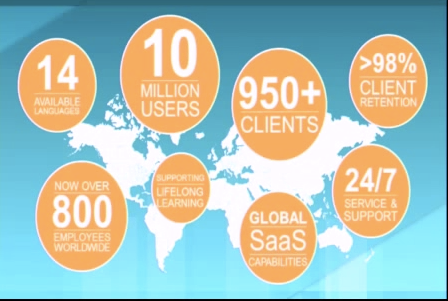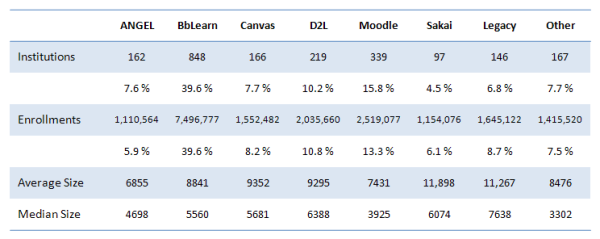Yesterday D2L announced a second round of investment, this time raising $85 million (a mix of debt and equity) to go with their $80 million round two years ago (see EDUKWEST for a useful roundup of news and article links). While raising $165 million is an impressive feat, does this funding give us new information on the LMS market?
First, here are the claims by D2L as part of this round of financing, from EdSurge:
The deal comes on the heels of what the company calls “a year of record growth in the higher education, K-12 and corporate markets.” John Baker, founder and CEO, says the company currently serves 1,100 institutions and 15 million learners–up from 850 and 10 million, respectively, at this time last year. The company also recently opened offices in Latin America, Asia Pacific and Europe.
That’s a 29% growth in the number of institutions and a 50% growth in the number of learners in just one year. Quite impressive if accurate.
Yet the company went through a significant round of layoffs in late 2013 that let go more than 7% of its workforce, and according to both LinkedIn data and company statements they have had no significant growth in number of employees over the past year. According to the EdSurge article, the company does plan to use the new money to hire more staff [emphasis added].
This time, the company says it will play it cool. “There are no planned acquisitions at this stage,” Baker tells EdSurge. “At this point, we’re primarily focused on building out our learning platform to support our clients and thousands of integration partners.” To do so, the company will grow its team of 783 full-time employees. “We are actively looking for dozens of new positions; over 60 in R&D alone,” shares Baker.
Note this slide from John Baker’s FUSION keynote one year ago:

If you take the information above – 800+ employees last year and 783 today – at face value, D2L has actually dropped in employee headcount. Does it make sense that a company can grow 50% in terms of learners without growing company employment, especially coming between two massive funding rounds?
Secondarily, what about the statement of “thousands of integration partners”? D2L is claiming to have more than twice as many integration partners as they do actual clients.
The other issue is market share. It is clear that D2L is planning to grow in corporate (10% of their business according to WSJ), K-12, and international higher ed markets; however, their largest business is still US higher ed. And here they have actually shown signs of no real growth, and for community colleges even dropping market share.
For the first time in an LMS market survey that I am aware of, Desire2Learn has actually lost market share. In fact, Desire2Learn is now lower than both Moodle and Canvas for community colleges according to this survey. This is a topic worth exploring further, especially in relation to last year’s layoffs.
Edutechnica ran the numbers for US higher education in October 2013.1

Edutechnica ran the numbers again for the end of June for 2,000 FTE and above (to allow an apples-to-apples comparison with Oct 2013), but they have not yet published the results. George did agree to share preliminary information with me, and D2L came out with 225 institutions and 2,084,089 enrollments.2 The Edutechnica numbers leads to an increase of 3% in number of US institutions and 2% in enrollment (number of learners) over the past 10 months. If D2L has grown its total number of learners by 50% over the past year, it would make sense that we would see very different numbers for their largest market.
In another interview with local media outlet The Star, CEO John Baker described growth this way:
“We’re seeing very rapid growth in Europe, we’ve seen triple-digit growth in Latin America and Asia Pacific. In terms of new accounts we’re seeing great growth basically everywhere we look,” Baker said. Desire2Learn is prioritizing growth in “key hubs,” including Brazil, Mexico, the U.S. and Singapore, he said.
This raises some questions:
- They mention growth everywhere they look, including the US. Where is this growth that is not showing up in market data?
- What percentage of their business – in terms of revenue, customers or learner counts – comes from international markets? The company press releases mention their investments in international hubs but I can find no significant news on new accounts with huge numbers.
D2L did not respond to several requests for comment or clarification for this post.
My intention in this and previous posts is to explain what I am seeing in the market and challenge the marketing claims – education institutions need an accurate understanding of what is happening in the LMS market. It is worth noting that not a single media outlet listed by EDUKWEST or quoted above (WSJ, Reuters, Bloomberg, re/code, edSurge, TheStar) challenged or even questioned D2L’s bold claims. It would help if more media outlets didn’t view their job as paraphrasing press releases.
Thanks, Phil, for keeping everybody honest! That’s the best policy for all of us, schools and service providers alike.
I would be willing to bet that the increase in customers is related to the acquisitions. Some of the companies they acquired have meaningful numbers of customers if not meaningful revenues.
Which ones? I cannot see Knowillage, Wiggio, or Degree Compass having more than dozens of customers / hundreds of thousands of learners (correct me if I’m wrong). Maybe Achievement Standards Network is where the numbers come from?
And as a counter argument to those speculating that D2L acquisitions are source of 5 million new learners, consider how D2L describes itself:
D2L’s open and extensible platform is used by more than 1,100 clients and 15 million learners in higher education, K-12, healthcare, government, and the enterprise sector including Fortune 1000 companies.
Does this not imply that the core platform is in use by 1,100 clients and 15 million learners – as in the platform?
Good discussion (cross-posting comment into G+ and blog comments).
Quick question: how much are companies like D2L using short-term contractors? The 783 are specifically mentioned as full-time staff, which might explain the growth/contraction discrepancy.
Higher education itself engages in some pretty grubby pea-and-cup accounting when it comes to staffing data. So maybe what we have here is the fusion of two sectors interested on growing market share opportunistically while keeping staffing costs both low and flexible/disposable, and using marketing to fend off actual reporting.
Thanks for your continued independent analysis.
Kate: I believe that ed tech companies like D2L do not use many short-term contractors (certainly not to the level that colleges & universities do). The biggest two areas of such usage in a company would be help desk support and summer / college internships. Here’s why I do not believe this is explanation for apparent lack of employee growth:
– D2L for the past several years has bragged about its growth, and I have checked against their PR (interviews, FUSION conference, web site); there is reason to believe they would not have changed methods (going from #s based on all employees to just FT employees) within the past year.
– Such a change would also not make sense, as they are trying to paint a picture of unstoppable growth (so why make a change that shows numbers dropping?).
– I know they had a layoff of at least 56 last fall (and possibly greater), which included forcing them to admit that it was larger than 25 and was based on 10+ interviews with current and former staff.
– They do not control LinkedIn numbers, where employees choose to link to D2L. The LinkedIn numbers show no growth since last fall (711 last fall, 715 today). If the FT employees had grown but description of total employees changed methods, LinkedIn data would likely show real growth.
Now as to your second paragraph about potential shifting towards more of a PT workforce – that is an interesting hypothesis, but I have not heard any word of such a shift. But then again I have not asked that explicitly. I don’t think this is happening, but I will now keep that in mind for future analysis / investigation.
I will again raise the prospect of Occam’s Razor and where my suspicions lie – the claimed growth numbers (29% growth in clients & 50% in learners *for their platform* and growth in all markets) are not accurate. By shifting our thinking to explore this possibility, consider a claim that was specifically mentioned of ‘triple-digit growth in Latin America’, yet there is only ONE LA client mentioned in the past year by press release. FGV of Brazil, by the way, has an enrollment of 2,200. Maybe they had one client in LA previously and FGV does represent triple-digit growth, but this does not support the overall growth claims.
That last paragraph was not really in direct response to your comment :}
To be fair I should add the Nottingham Trent University initiative and Brazilian delegation discussions: http://www.d2l.com/press/releases/brazilian-universities-turn-to-desire2learn-and-nottingham-trent-university-to-engage-in-strategic-discussions-on-the-future-of-learning/.
There are no actual LA clients mentioned, but trying to give the benefit of the doubt here.
Wiggio does claim 1.5 million users and 150,000 groups. These are obviously not all paying customers, but one can see how someone with an elastic definition of institutional customers would find some promising raw material here.
Matt – very good point about Wiggio.